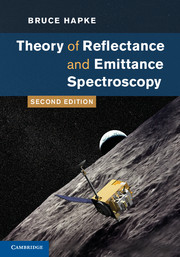Book contents
- Frontmatter
- Contents
- Acknowledgments
- 1 Introduction
- 2 Electromagnetic wave propagation
- 3 The absorption of light
- 4 Specular reflection
- 5 Single-particle scattering: perfect spheres
- 6 Single-particle scattering: irregular particles
- 7 Propagation in a nonuniform medium: the equation of radiative transfer
- 8 The bidirectional reflectance of a semi-infinite medium
- 9 The opposition effect
- 10 A miscellany of bidirectional reflectances and related quantities
- 11 Integrated reflectances and planetary photometry
- 12 Photometric effects of large-scale roughness
- 13 Polarization of light scattered by a particulate medium
- 14 Reflectance spectroscopy
- 15 Thermal emission and emittance spectroscopy
- 16 Simultaneous transport of energy by radiation and thermal conduction
- Appendix A A brief review of vector calculus
- Appendix B Functions of a complex variable
- Appendix C The wave equation in spherical coordinates
- Appendix D Fraunhofer diffraction by a circular hole
- Appendix E Table of symbols
- Bibliography
- Index
16 - Simultaneous transport of energy by radiation and thermal conduction
Published online by Cambridge University Press: 05 January 2012
- Frontmatter
- Contents
- Acknowledgments
- 1 Introduction
- 2 Electromagnetic wave propagation
- 3 The absorption of light
- 4 Specular reflection
- 5 Single-particle scattering: perfect spheres
- 6 Single-particle scattering: irregular particles
- 7 Propagation in a nonuniform medium: the equation of radiative transfer
- 8 The bidirectional reflectance of a semi-infinite medium
- 9 The opposition effect
- 10 A miscellany of bidirectional reflectances and related quantities
- 11 Integrated reflectances and planetary photometry
- 12 Photometric effects of large-scale roughness
- 13 Polarization of light scattered by a particulate medium
- 14 Reflectance spectroscopy
- 15 Thermal emission and emittance spectroscopy
- 16 Simultaneous transport of energy by radiation and thermal conduction
- Appendix A A brief review of vector calculus
- Appendix B Functions of a complex variable
- Appendix C The wave equation in spherical coordinates
- Appendix D Fraunhofer diffraction by a circular hole
- Appendix E Table of symbols
- Bibliography
- Index
Summary
Introduction
The temperature distribution in the regolith of a body of the solar system is important for several reasons. First, the mean temperature is one of the fundamental properties of an object; second, the regolith is the part of the planet studied by remote-sensing methods; and third, the temperature distribution in the upper layers constitutes the boundary condition for thermal models of the deeper interior. The temperatures in the regolith are governed by three energy-transport processes that interact within the medium: visible and near-IR solar radiation, thermal radiation, and heat conduction. However, most models treat the energy as being carried entirely by thermal conduction inside the medium, the interaction with radiation being treated only as a boundary condition. In this chapter all three processes occurring in the medium are treated simultaneously. In doing so it will be seen that radiative conductivity of heat and the solid-state greenhouse effect appear intrinsically without any ad hoc assumptions.
In Section 16.2 the time-dependent, one-dimensional radiative and heat conduction equations are introduced. The time-independent equations are solved analytically for two important cases: a layer of isotropically scattering particles heated from below and radiating into a vacuum, simulating conditions often used in laboratory IR and thermal measurements, and a semi-infinite medium of isotropic scatterers heated by incident visible light and radiating into a vacuum, simulating a planetary regolith in equilibrium with sunlight. In the final section some time-dependent problems are discussed briefly.
- Type
- Chapter
- Information
- Theory of Reflectance and Emittance Spectroscopy , pp. 440 - 462Publisher: Cambridge University PressPrint publication year: 2012



